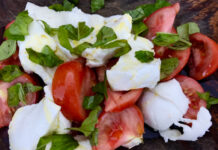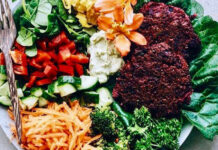Is cheese vegetarian? No. Let’s try to clarify the concept.
What is cheese?
‘The name cheese or cacio is intended for the product which is made from whole milk, or partially or wholly skimmed milk, or from cream, following acid or presamic coagulation, including making use of ferments and cooking salt.’ (1)
The conditions for talking about cheese are therefore two, the use of milk or cream as the ingredient-base, and the coagulation process. (2)
What rennet?
Milk coagulation can be achieved with three types of rennet:
– Animal rennet, extracted from the stomachs of goats, sheep or lactating cattle. The one most commonly used to make cheese,
– vegetable rennet, obtained from flowers or plants such as wild thistle (Cynara cardunculus), (3) artichoke, fig, fennel,
– Microbial rennet, which is obtained from fungi or molds, sometimes genetically modified. (4)
Is cheese vegetarian?
The legal designation ‘cheese’, in the European lexicon, can be used without distinction with respect to the type of rennet used. Operators, in turn, are not required to specify the nature of rennet on the label.
Vegetarian? The European Commission has yet to define‘information regarding the suitability of a food for vegetarians or vegans‘. As called for by the European legislature back in 2011. (5)
The proposal of the European Vegetarian Union
In the meantime, the European Vegetarian Union, a recognized European association, has proposed that Brussels adopt a legal definition, reproduced below in the original text:
–‘Vegan are foods that are not products of animal origin and in which, at no stage of production and processing, use has been made of or the food has been supplemented with
– ingredients (including additives, carriers, flavourings and enzymes) or
– processing aids or
– substances which are not food additives but are used in the same way and with the same purpose as processing aids in either processed or unprocessed form that are of animal origin.
– Vegetarian are foods which meet the requirements of paragraph 1 with the difference that in their production
1. milk,
2. colostrum,
3. eggs (No. 5 of Annex I to Regulation (EC) No. 853/2004),
4. honey (Annex I to Directive 2001/110/EC),
5. beeswax,
6. propolis or
7. wool grease including lanolin derived from the wool of living sheep or their components or derivatives may be added or used’.
How to check if cheese is vegetarian
Is cheese vegetarian? According to the definition proposed by the European Vegetarian Union, which moreover corresponds to the common feeling of informed consumAtors who adhere to the vegetarian diet, only when it is made with vegetable or microbial rennet.
How to recognize vegetarian cheese? Looking at the ingredient list on the product label, first of all. Check whether ‘vegetable rennet’ or ‘microbial rennet’ is specified, i.e., whether the product is certified (albeit, self-certified) as ‘vegetarian’. Otherwise, consult the website or the operator himself.
Notes
(1) Royal Decree 15.10.1925 no. 2033, Article 32
(2) Ricotta therefore, for example, is a dairy product and not a cheese, as it is made without coagulation
(3) Caciofiore for example, in the Roman and Abruzzese traditions, is coagulated through the use of thistle
(4) However, the use of genetically modified microorganisms is not subject to the requirements for specific labelling of GMOs. See in this regard our free ebook GMO, the Big Scam, at https://www.greatitalianfoodtrade.it/libri/ogm-la-grande-truffa
(5) According to EU Regulation 1169/11, the name ‘cheese’ may be used to designate ‘Any species of cheese when cheese or a mixture of cheeses constitutes an ingredient of another food, provided that the name and presentation of the latter does not refer to a specific species of cheese’ (Annex VII, Part B, point 6)
(6) Reg. EU 1169/11, Art. 36.3(b)
Dario Dongo, lawyer and journalist, PhD in international food law, founder of WIISE (FARE - GIFT - Food Times) and Égalité.








